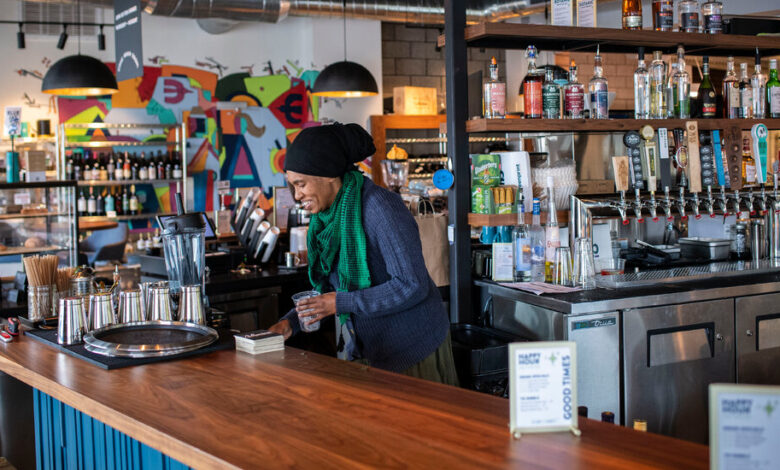Priced Out of Housing, Communities Take Development Into Their Own Hands

TRAVERSE CITY, Mich. — As the owner of the coffee retailer Higher Grounds Trading Company, Chris Treter had a problem: Business was booming, but his new hires couldn’t find affordable places to live.
“Traverse City is becoming Myrtle Beach meets Hilton Head — a place catering to a population outside the region,” Mr. Treter said. “Our work force can’t live here anymore.”
Mr. Treter and others in this small Lake Michigan community with a population of nearly 16,000 came up with a solution: a 47,000 square-foot building that offered spaces for residences, businesses and community activities that had been in short supply as gentrification in the city pushed prices up and local residents out.
What sets this project apart from others like it is how it’s paid for. Mr. Treter developed the space with Kate Redman, a lawyer who works with nonprofit organizations, and several other entrepreneurs who were dealing with similar challenges. They created a crowdfunding campaign that recruited nearly 500 residents to invest $1.3 million as a down payment to help finance the project’s construction and earn up to 7 percent annually in dividend payments. Roughly 500 more residents contributed $50 each to join the project as co-op members.
The $20 million development, called Commongrounds, opened late last year. It is at full occupancy and consists of 18 income-based apartments (rent below market rate based on median income), five hotel-like rooms for short-term rentals, a restaurant, three commercial kitchens (for the restaurant and to be used for events and classes), a food market, a coffee training center (for new hires and developing new drinks), a 150-seat performing arts center, a co-working space, offices and a Montessori preschool.
The owners, made up of over 1,000 co-op members, also embrace a cooperative management approach to operations. Shareholders, business tenants and apartment renters elect the project’s nine-member board of directors.
Commongrounds is the latest and largest example of what developers of similar projects across the United States call “community-owned cooperative real estate.” The strategy was developed a decade ago by a nonprofit legal group and a nonprofit neighborhood group in Oakland, Calif., and has been refined by legal and development groups in Atlanta, Boston, Minneapolis, Philadelphia, Portland, Ore., and other cities.
The cooperative strategy enables neighborhood groups to finance unconventional construction or renovation projects that banks and institutional lenders, which prefer strong cash-flow operations, won’t touch.
“It’s part of a robust movement for community control and affordable real estate, rather than enabling high-priced development at the whims of the market,” said Mohit Mookim, a lawyer at the Sustainable Economies Law Center, a nonprofit group in Oakland that helped develop the strategy.
Much of the approach stems from efforts by the federal and local governments to make it easier for small investors to put money into real estate developments. Federal rules once barred small investors — those whose net worth is less than $1 million or who make less than $200,000 a year in income — from participating in development projects; that changed in 2015. At the same time, a few states enacted laws allowing small investors to put their money into local developments.
“Until that change, 90 percent of the residents in a community couldn’t make direct investments in a real estate project,” said Chris Miller, the board chairman of the National Coalition for Community Capital, a nonprofit group. “Michigan allows nonaccredited investors to invest up to $10,000 in a project now. That was unheard-of before.”
Cooperative developments can now be found throughout the country. For this article, we identified roughly 15 cooperatively owned projects in the United States. Here are a few of them:
In Oakland, the East Bay Permanent Real Estate Cooperative is widely credited with being one of the first community groups to apply the community-owned cooperative concept to a neighborhood project. In 2019, the group raised $185,000 from a crowdfunding campaign that attracted more than 25 investors to help finance a $1.3 million project to buy and renovate Co-op 789, a four-unit apartment building in North Oakland.
Noni Session, a co-founder and the director of East Bay Permanent Real Estate Cooperative, said community-owned cooperative projects responded to the economic disruption caused by what she called the “standard capital pathway” of conventional development. Developers and private bankers who live and work outside the city, she said, typically ignore local residents as they pursue projects that are heralded as “neighborhood revitalization.”
“Almost all of that overlooks every single person in a nonaffluent community like West Oakland,” Ms. Session said. “Our model is economic inclusion. The goal is to reclaim our city and recapture power for how it develops.”
In Boston, 81 community investors raised $142,500 to start construction in 2022 on a vacant lot on Dorchester Avenue for a five-story building that consisted of 29 affordable apartments and a bookstore on the ground floor.
The developer, TLee Development, recruited the individual investors for the $9.65 million project, which was completed last year.
“We’re involved in 15 projects like this around Boston,” said Declan Keefe, a co-founder of CoEverything, a Boston architecture and development consultancy that specializes in community-owned cooperative projects. “The focus is community ownership so that people aren’t being displaced.”
In Atlanta, a worker-owned cooperative called the Guild established the Community Stewardship Trust, in which local residents could buy shares and have a say in future projects that the Guild is involved with. The Guild’s first project is the purchase of an abandoned 7,000-square-foot building on Dill Avenue that it is expanding to 21,000 square feet for 18 units of affordable housing, a grocery store, a co-working space and three commercial kitchens. The project is expected to open this year.
“Our goal is making sure that in neighborhoods that are gentrifying, the people that made these neighborhoods great get to benefit from the development that’s happening,” said Nikishka Iyengar, the founder and director of the Guild.
In Traverse City, Commongrounds was driven by some of the same principles of affordability and community oversight. Once a temperate seasonal beachfront outpost, the city has added 1,000 new residents over the past decade and evolved into a busy, increasingly expensive all-season urban center.
Downtown is booming with new and expensive residential and commercial construction. A one-bedroom apartment typically rents for over $1,900 a month, while annual median individual incomes have barely nudged above $31,000. The median price for homes climbed to nearly $400,000 in February, more than twice what it was in 2010.
Joe Sarafa, a local developer and property manager, helped guide Mr. Treter through the details of buying the half-acre Commongrounds site along the Boardman River, which flows through the city. Eight residents, most of them prominent community activists, invested $550,000 to buy the property and become the project’s first investors.
Ms. Redman, with the help of volunteers, organized public meetings to decide the project’s core mission and develop the crowdfunding strategy. They worked with city officials to adjust several zoning restrictions, such as drastically reducing parking requirements.
Another important player was Jeff Hickman, a vice president of Coastal States Bank who lives in Traverse City and arranged $8 million in rural business and industry loan guarantees from the U.S. Department of Agriculture. The balance was funded by a nonprofit lender, and state and county grants.
The finished building, with its sunlight-filled public spaces and inviting offices and residences, was designed by Ray Kendra, a local architect.
“What I want to do now is work on more community-owned projects,” said Ms. Redman, who manages the building’s staff. “There’s interest here to develop more housing and more real estate that meets community needs.”



